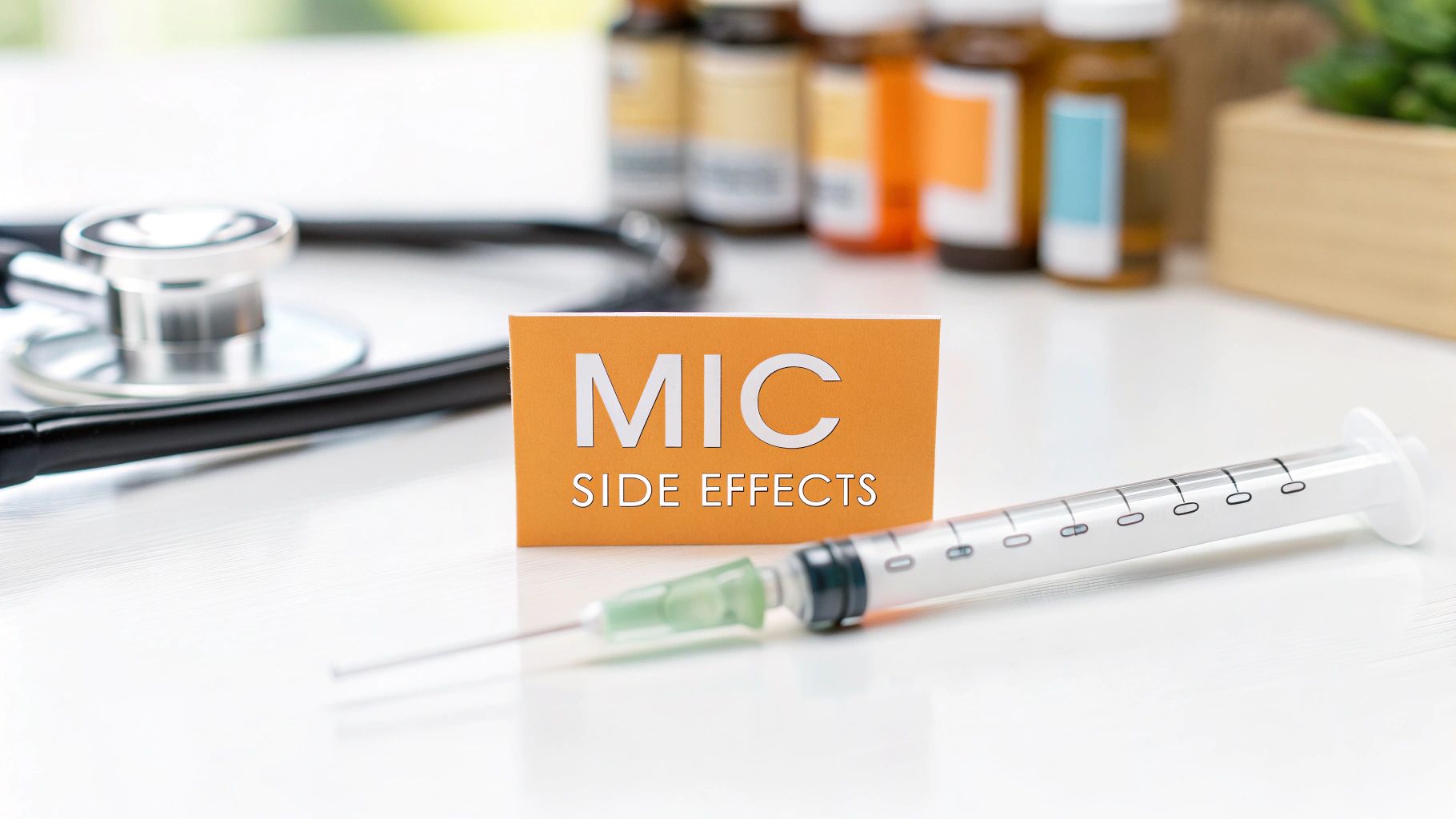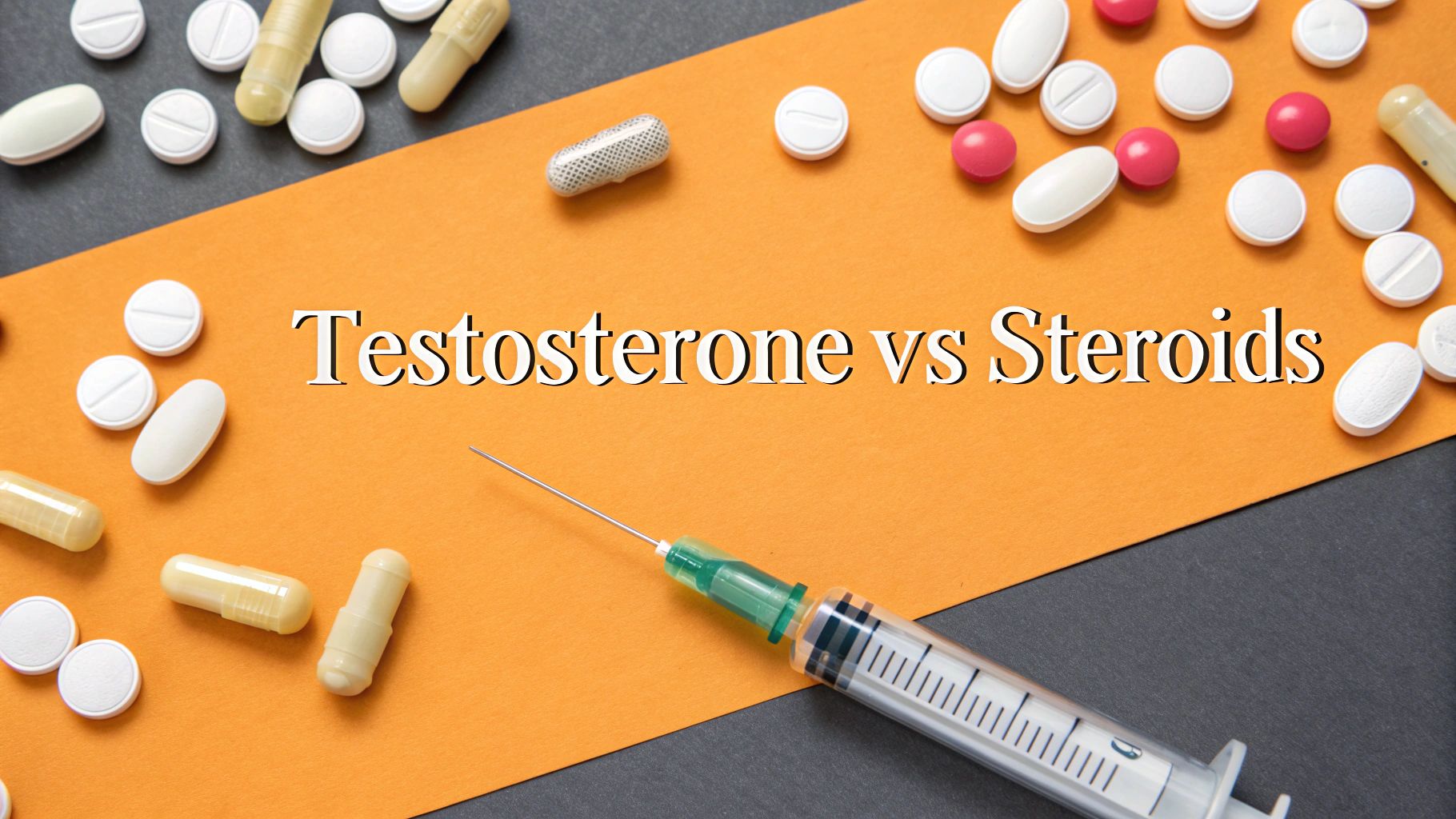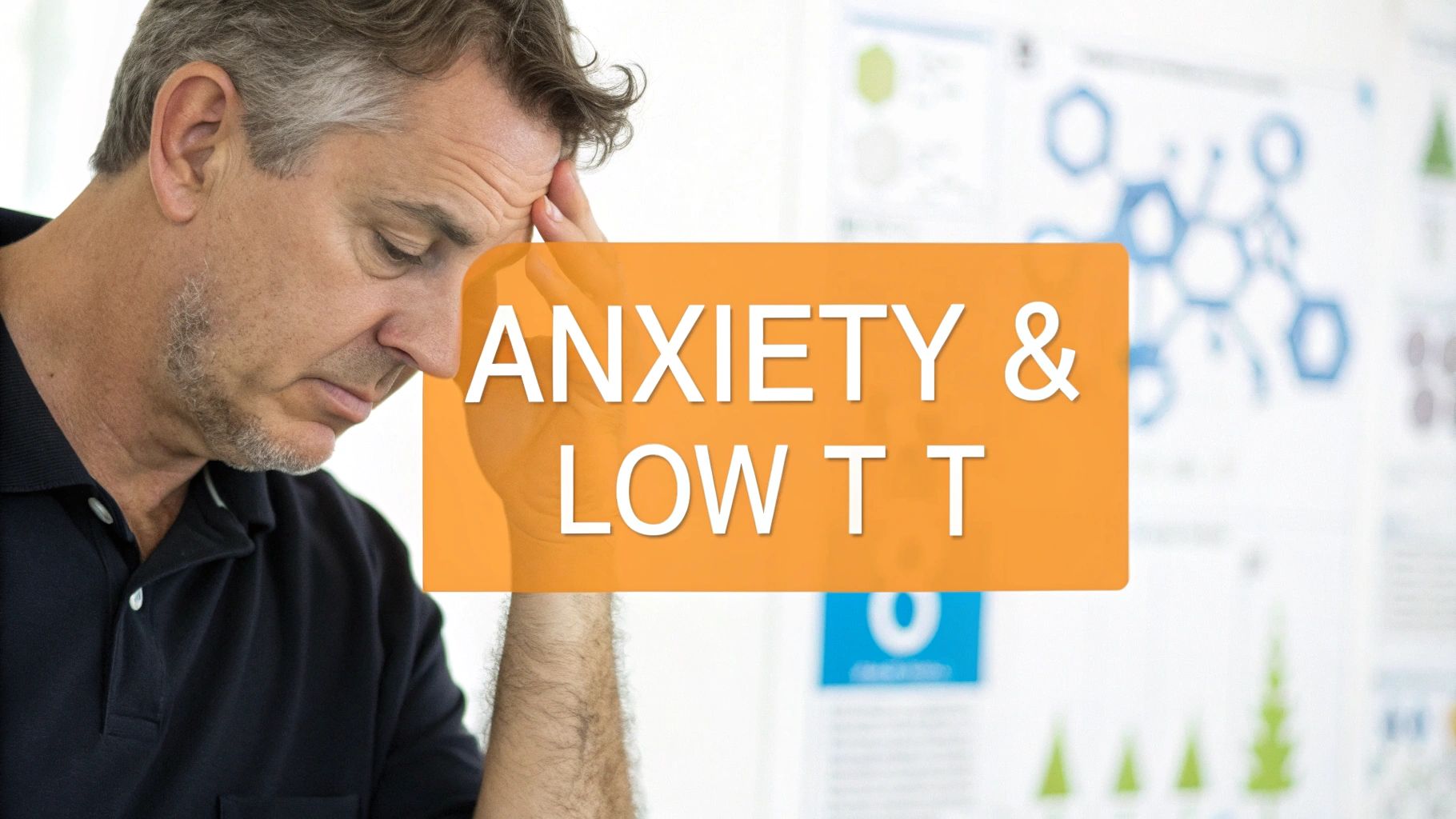Can Hormone Replacement Therapy Cause Hair Loss? Find Out Now
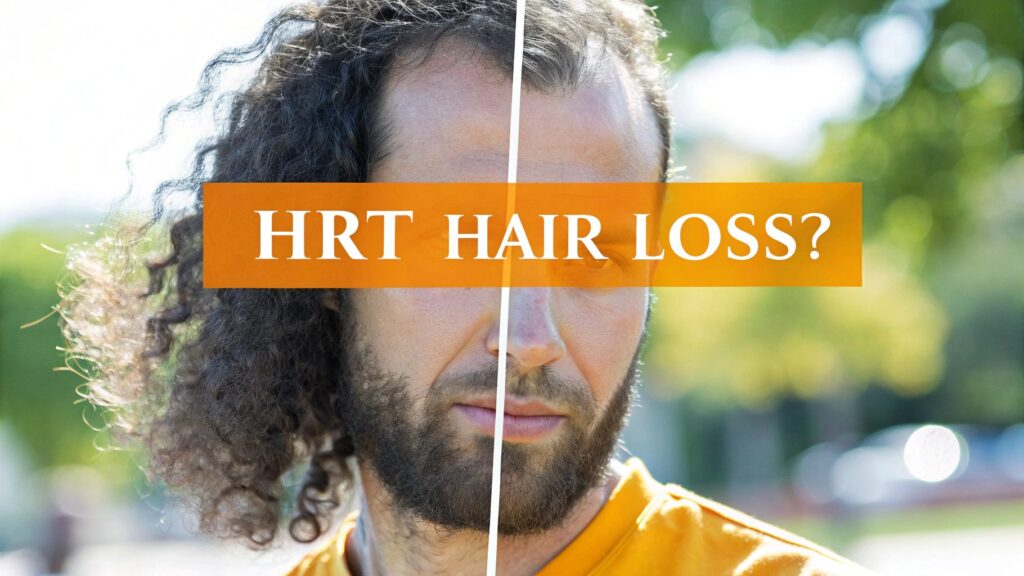
Yes, hormone replacement therapy (HRT) can cause hair loss, but it's certainly not a given for everyone. Think of it less as a guaranteed side effect and more as a possibility that hinges on a unique combination of factors: the specific hormones in your therapy, your own genetic wiring, and how your body reacts to hormonal shifts.
The Link Between HRT and Hair Loss Explained

To really get how HRT might lead to thinning hair, it helps to imagine your hair follicles as a carefully tended garden. Different hormones act like different kinds of plant food—some encourage robust growth, while others can be surprisingly damaging under the right (or wrong) conditions.
Your body’s hormones don't work in isolation; they exist in a delicate, constantly shifting balance. When you introduce external hormones through HRT, you're essentially altering that finely tuned ecosystem. Sometimes, this disruption can trigger unexpected changes, and hair thinning is one of them.
The Role of Androgens
The main players behind most hormone-related hair loss are androgens, often called "male" hormones like testosterone. While everyone has androgens, it's their levels and your body's sensitivity to them that can make all the difference for your hair.
When your body metabolizes testosterone, it creates a powerful byproduct called dihydrotestosterone (DHT). For people with a genetic sensitivity to DHT, this potent androgen can bind to hair follicles, causing them to shrink. This process, known as miniaturization, shortens the hair's growth phase until, eventually, the follicle stops producing visible hair altogether. This is the root cause of androgenetic alopecia, or common pattern hair loss.
Hormone-driven hair loss is an incredibly common experience. It's estimated that roughly 85% of men and 33% of women will face some form of it in their lifetime, with hormones being a major factor in most cases. You can learn more about the prevalence of hormonal hair loss and its causes to see just how widespread it is.
HRT can stir the pot in a few key ways:
- Introducing Testosterone Directly: Therapies that include testosterone will naturally increase the amount of DHT your body produces, potentially triggering follicle shrinkage if you're genetically predisposed.
- Using Certain Synthetic Progestins: Some synthetic versions of progesterone, known as progestins, have what's called "androgenic properties." This means they can act a bit like testosterone in the body, contributing to hair thinning in sensitive individuals.
- Shifting the Balance: Even therapies that don't contain direct androgens can throw off the ratio of estrogen to testosterone. This can make the androgens you already have more impactful on your hair follicles.
Before we go deeper, here’s a quick snapshot of the key factors that determine your personal risk of experiencing hair loss while on HRT.
Quick Guide to HRT and Hair Loss Risk
This table offers a snapshot of the key factors that determine your risk of experiencing hair loss while on hormone replacement therapy.
| Influencing Factor | Potential Impact on Hair |
|---|---|
| Genetic Predisposition | If pattern hair loss runs in your family, you have a higher baseline risk. HRT could act as a trigger. |
| Type of Hormones Used | Formulations with testosterone or androgenic progestins pose a greater risk than those with bioidentical or non-androgenic hormones. |
| Individual Sensitivity to DHT | Even with normal androgen levels, high sensitivity in your hair follicles can lead to thinning. This is determined by genetics. |
| Hormonal Balance | Shifting the ratio of estrogen to testosterone can make existing androgens more potent, even if their absolute levels don't increase. |
| Dosage and Formulation | The specific dose and delivery method (e.g., creams, patches, injections) can influence how hormones are metabolized and impact hair. |
Ultimately, whether you see changes in your hair depends entirely on the interplay between your specific HRT formula and your unique genetic makeup. HRT might be the trigger, but genetics loads the gun.
Understanding Your Natural Hair Growth Cycle
To get why hormone replacement therapy might trigger hair loss for some, we first need to look at how your hair grows in the first place. Think of each hair on your head as following a pre-programmed script with three distinct acts. This entire process is the hair growth cycle, and hormones are the directors, telling each follicle when it's time to grow, rest, or fall out.
At any given time, about 85% to 90% of your hair is actively growing. When something interrupts this finely-tuned cycle—like a major hormonal shift—you can start to see changes like thinning or more hair in the drain. A healthy cycle is all about balance, but the hormones introduced during HRT can sometimes rewrite the script.
The Three Phases of Hair Growth
Your hair’s entire life is broken down into three stages. Once you understand them, you can pinpoint exactly where HRT might be stepping in and causing trouble.
-
The Anagen (Growth) Phase: This is the main event—the active growing stage. Down in the hair bulb, cells are rapidly dividing to build new hair, which shoves the old, resting hair right out of the follicle. For the hair on your scalp, this phase can last anywhere from 2 to 7 years, which is what determines how long your hair can ultimately get.
-
The Catagen (Transition) Phase: After years of growth, the hair gets the signal to wrap things up. This is a very short transitional period, lasting only about 2 to 3 weeks. During this time, the hair follicle starts to shrink and pulls away from its blood supply, officially ending the growth process.
-
The Telogen (Resting) Phase: This is the final act, where the follicle takes a break for about 3 months. The old hair, now called a club hair, just sits there until a new anagen hair starts growing underneath and pushes it out. It's completely normal to shed 50 to 100 of these telogen hairs every single day.
The real problem in most types of hair loss, including those tied to HRT, isn't just about shedding more. It's often that the Anagen (growth) phase gets shorter while the Telogen (resting) phase gets longer. This results in finer, shorter hairs that don't have the chance to mature, leading to less volume over time.
This constant, rhythmic cycle is what keeps your scalp covered with a consistent density of hair. But when certain hormones, particularly androgens, become more dominant—as they can with some HRT plans—they can directly shorten that crucial Anagen phase. This disruption means hair doesn't get enough time to grow long and strong, kicking off the miniaturization process that we see in pattern hair loss. With that foundation in place, let's dive into how specific hormones can throw a wrench in this cycle.
How Specific Hormones in HRT Impact Your Hair
To figure out if hormone replacement therapy might be causing your hair loss, we have to look at what's actually in your prescription. Think of each hormone in your HRT formula as a specific instruction sent directly to your hair follicles. Some of these messages tell your hair to grow, while others can, unfortunately, signal it to shut down.
This infographic gives a great visual breakdown of the relationship between HRT and your hair's health.
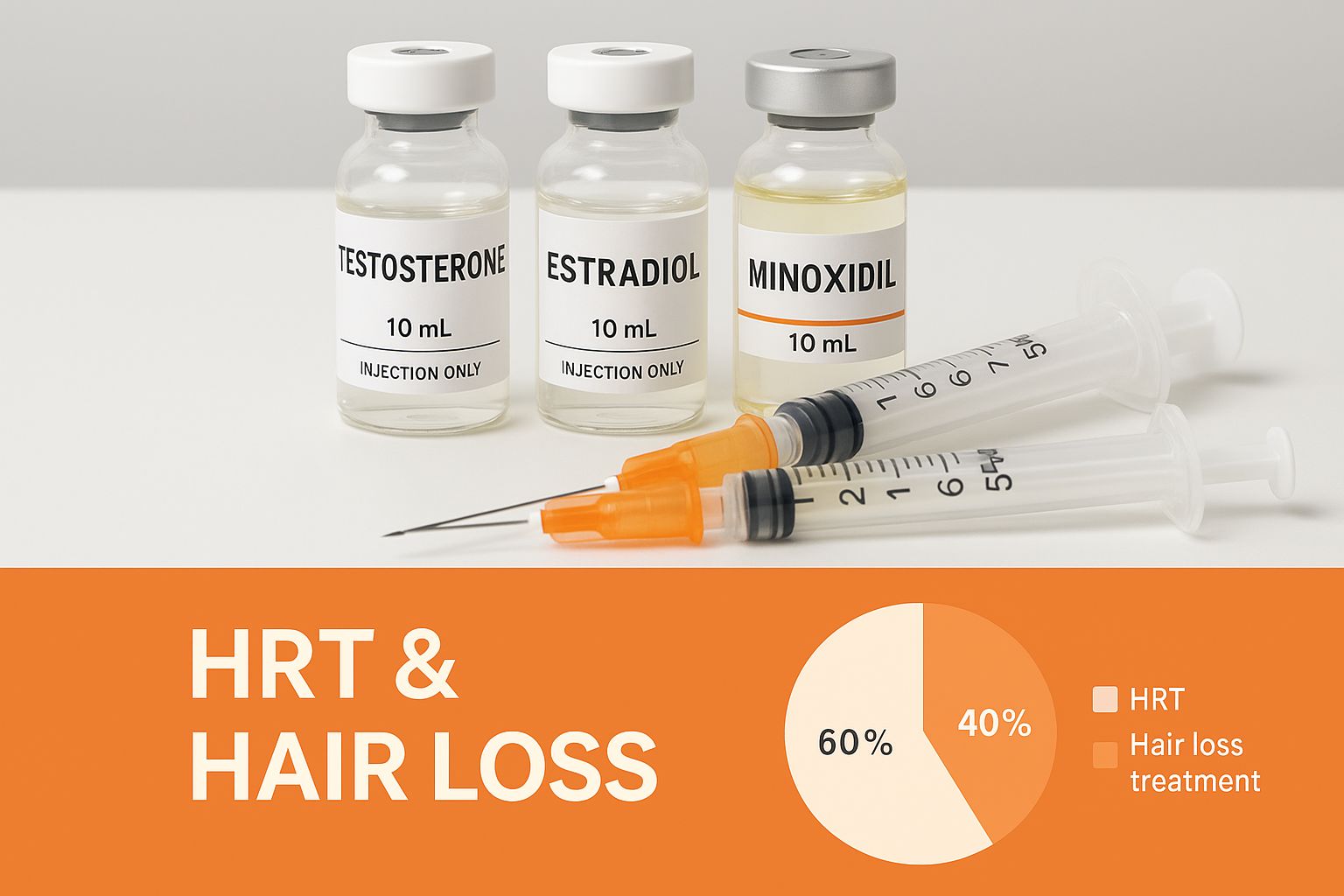
As you can see, the specific hormones in your therapy are the single biggest factor in determining whether your hair will thrive or start to thin.
Estrogen: The Hair Protector
In the world of hormones and hair, estrogen is generally your best friend. It helps to lengthen the anagen, or growth phase, of the hair cycle. This means each strand of hair stays on your head for a longer period, giving it more time to grow and contributing to a fuller, thicker look.
This is exactly why many women notice their hair seems healthier and more voluminous during pregnancy when estrogen levels are naturally high. When HRT is used to supplement estrogen, it can offer a similar protective effect, helping to shield your follicles from the shrinking influence of androgens.
Progesterone: The Balancing Act
Progesterone's role is a bit more complicated—it's all about balance. Natural, bioidentical progesterone can be a big help by blocking the conversion of testosterone into DHT, the potent androgen that's notoriously damaging to hair follicles. By keeping DHT levels under control, it supports estrogen's efforts to maintain a healthy growth cycle.
However, the game changes when we talk about certain synthetic progestins. Some of these man-made versions have "androgenic properties," meaning they act a lot like testosterone in the body. If your HRT includes an androgenic progestin, it could accidentally be contributing to hair thinning, even while the estrogen in your formula is trying to help. This is a great reason to discuss alternatives, like bioidentical hormone replacement therapy, with your doctor.
To make this clearer, let's compare how the main hormones in HRT can either help or hinder your hair's health and growth cycle.
Hormone Effects on Hair Follicles
| Hormone | Potential Positive Effect on Hair | Potential Negative Effect on Hair |
|---|---|---|
| Estrogen | Extends the anagen (growth) phase, leading to longer, thicker-feeling hair. | Minimal negative effects; primarily protective. |
| Bioidentical Progesterone | Can inhibit the conversion of testosterone to DHT, protecting follicles from miniaturization. | Generally hair-friendly; negative effects are rare. |
| Synthetic Progestins | Varies by type; some have no negative impact. | Some have androgenic properties that can mimic testosterone, leading to follicle shrinkage and thinning. |
| Testosterone/DHT | In cases of deficiency, can restore growth. | Binds to genetically sensitive follicles, causing miniaturization and leading to pattern hair loss. |
This table shows just how much the type of hormone matters. The distinction between bioidentical progesterone and certain synthetic progestins can make all the difference for someone with hair thinning concerns.
Testosterone: The Double-Edged Sword
Testosterone and its more powerful derivative, DHT, are the main culprits behind androgenetic alopecia, or pattern hair loss. When HRT introduces or increases testosterone, it can speed up thinning, but only in people who already have a genetic predisposition. The extra androgens latch onto hair follicles, causing them to shrink and, eventually, stop producing hair altogether.
But the effect isn't always negative, especially if you're correcting a true deficiency. A fascinating 2011 study on women with androgen deficiency found that while 27% reported hair thinning before starting treatment, a whopping 63% of them actually experienced hair regrowth after starting testosterone therapy. This really drives home the point that achieving hormonal balance—not just adding or subtracting hormones—is the ultimate goal for healthy hair.
Understanding how each of these hormones works empowers you to have a much more informed and productive conversation with your healthcare provider about your specific HRT formula.
Key Risk Factors for HRT-Related Hair Thinning
Let's be clear: not everyone on hormone replacement therapy will suddenly start losing their hair. Whether you see changes often comes down to a mix of factors, with HRT acting as a potential trigger—not the sole culprit. Understanding these risk factors is the first step to figuring out where you stand.
By far, the biggest piece of the puzzle is your genetic predisposition. If male or female pattern baldness runs in your family, you've inherited hair follicles that are extra sensitive to androgens like DHT. In this case, HRT isn't creating a new problem; it's simply flipping a switch that was already wired into your DNA.
Genetic Sensitivity to Androgens
Think of your genes as holding a pre-written script for pattern hair loss. For some, that script is set to play out no matter what. For others, it needs a cue to get started. Androgenic hormones introduced through an HRT plan can be that cue, telling your follicles to begin the thinning process.
This is exactly why two people on the same HRT protocol can have completely different experiences. One might rave about thicker, healthier hair, while the other starts noticing thinning at the crown or temples. It all comes back to the unique instructions coded in their genes.
Underlying Health Conditions
HRT is almost never the only thing influencing your hair's health. Several other conditions can contribute to thinning, and the hormonal shifts from therapy can pour fuel on an existing fire.
- Thyroid Disorders: Your thyroid is the master regulator of your metabolism, which includes your hair growth cycle. An undiagnosed or poorly managed condition like Hashimoto's or Graves' disease can disrupt this cycle on its own. Add HRT to the mix, and you can create a perfect storm for shedding.
- Nutritional Deficiencies: Hair follicles are hungry. They need a steady supply of specific nutrients to build strong, healthy hair. If you're low in essentials like iron (specifically, your ferritin stores), vitamin D, or zinc, your hair is already in a weakened state and more vulnerable to hormonal triggers.
- High Stress Levels: Chronic stress floods your body with cortisol. This stress hormone can shock a large number of hair follicles into the resting (telogen) phase all at once. This leads to a diffuse, all-over shedding known as telogen effluvium, which can easily be mistaken for or worsen any thinning related to HRT.
It's crucial to see hair loss as a puzzle with multiple pieces. HRT might be a significant piece, but genetics, nutrition, and overall health form the rest of the picture. Addressing only one element often isn't enough to solve the problem.
Digging into these other areas is essential to get the full story behind any changes you're seeing. For a deeper dive into other potential effects, you can learn more about hormone replacement therapy side effects to get a complete perspective. A holistic view is your best tool for managing your health effectively.
How HRT and Hair Loss Play Out in the Real World

This is where the science meets real life. To see how these hormonal shifts actually work, let's walk through a few scenarios. These examples show just how different the experience can be from one person to the next, proving there’s no such thing as a one-size-fits-all outcome with HRT.
Take Sarah, a post-menopausal woman starting an estrogen-only therapy. Before HRT, she’d been noticing her hair was thinning out and shedding more than it used to. But a few months into her treatment, she sees a welcome change—her hair feels fuller, and the shedding has slowed down. The estrogen is doing its job, helping to keep her hair follicles in their growth phase longer.
When Androgens Enter the Picture
Now, let's consider Alex, a transgender man beginning masculinizing hormone therapy (MHT) with testosterone. He's excited about the changes happening, but after about a year, he starts to see his hairline receding. This is a textbook example of HRT flipping the switch on a genetic predisposition to pattern baldness. The introduced androgens are converting to DHT, and his hair follicles are responding.
This isn't an unusual story. Research confirms that while the risk isn't the same for everyone, introducing androgens can definitely trigger hair loss if the genetic tendency is there. One study noted that the rate of androgenetic alopecia diagnosis jumped from 0.4% before therapy to 3.1% after starting MHT, with new cases sometimes popping up years into treatment. You can find more data on this topic in the full study.
The key takeaway here is that HRT doesn't create pattern hair loss out of thin air—it can only awaken the genetic potential that was dormant. Alex's experience is a direct result of his new hormonal environment interacting with his DNA.
The Impact of Specific Formulations
Finally, let's look at Maria. She was prescribed an HRT blend that included a synthetic progestin known for its androgenic (male-hormone-like) properties. To her distress, she began experiencing diffuse shedding all over her scalp.
After talking it over with her doctor, they switched her to a different formula—one using bioidentical progesterone, which doesn't have those androgenic effects. Within about six months, her shedding slowed dramatically, and her hair started to regain its old density. Maria’s story shows how a simple change in the type of hormone can completely flip the script on hair loss.
It's a powerful reminder of how vital it is to understand exactly how hormone replacement therapy works and to keep an open line of communication with your provider about any side effects. As you can see, the answer to whether HRT causes hair loss really depends on the person, their genes, and the specific treatment they're on.
What to Do If HRT Is Affecting Your Hair
If you're noticing more hair in your brush and suspect your hormone replacement therapy is the culprit, the best thing you can do is take action. This isn't something you just have to live with. Your first move, and the most important one, is to talk to your healthcare provider. Open, honest communication is the foundation for finding a solution that works for you.
Often, a simple tweak to your HRT formula can make all the difference. For example, if your current plan uses a synthetic progestin known for its androgenic (male hormone-like) effects, your doctor might suggest switching to bioidentical progesterone. For many people, just removing that androgenic trigger is enough to slow, stop, or even reverse the shedding.
Building a Pro-Hair Health Strategy
Beyond adjusting your prescription, you can make several lifestyle and treatment changes to create an environment where your hair can truly flourish. Think of these as supportive pillars holding up your main medical strategy.
One of the most trusted topical treatments is minoxidil, which you probably know as Rogaine. It's available over the counter and works by waking up tired hair follicles and encouraging them to stay in their growth phase longer. It requires consistency and long-term use to see and maintain results, but it can significantly improve hair density for many people.
Remember, tackling hair loss on HRT is rarely a one-shot deal. It's a combination of medical adjustments, supportive hair care, smart nutrition, and stress management that creates the best possible outcome.
Nourish from Within and Keep Calm
What you eat has a direct impact on the strength and resilience of your hair. Make sure your diet is packed with the nutrients that build strong, healthy hair from the inside out.
- Iron-Rich Foods: Low ferritin (your body's iron storage) is a very common and often overlooked cause of hair shedding. Load up on foods like spinach, lentils, and lean red meat.
- Quality Protein: Your hair is literally made of protein. Giving your body enough chicken, fish, eggs, and beans provides the essential building blocks for strong strands.
- Be Gentle: Give your hair a break. Avoid harsh chemical treatments, tight hairstyles that pull at the scalp, and excessive heat styling. All of these create physical stress and breakage, which can make thinning look worse.
Finally, get a handle on your stress. Chronic stress floods your body with cortisol, a hormone that can push a large number of hair follicles into the shedding phase all at once. Simple practices like meditation, yoga, or even a daily walk can help lower those stress levels, creating a calmer internal environment that supports your hair growth goals.
Common Questions About HRT and Hair Loss
Working through the details of hormone therapy can bring up a lot of questions, especially when it comes to something as personal as your hair. Let's tackle some of the most common concerns head-on to give you the clear, straightforward answers you need.
Will My Hair Grow Back If I Stop HRT?
If your HRT regimen is the main reason your hair is thinning, then stopping or tweaking your treatment can often allow your hair to return to its previous state. This is especially the case if the hair loss is a recent development linked to a temporary shedding phase called telogen effluvium.
However, if HRT simply sped up an underlying genetic tendency for pattern hair loss, stopping it will likely just slow down future thinning. It might not bring back what you've lost without some extra help from treatments like minoxidil.
Is Hair Loss More Common with Bioidentical or Synthetic Hormones?
The risk of hair loss doesn't really come down to the "bioidentical" versus "synthetic" label. It’s all about the specific properties of the hormone being used. For example, certain synthetic progestins are well-known for their androgenic effects, meaning they can act a bit like testosterone and trigger shedding if you're sensitive.
On the flip side, bioidentical testosterone is a direct androgen itself and can absolutely cause hair loss if you're genetically prone to it. The key factor is the androgenic activity of whatever hormones you're prescribed, which is something you should always discuss with your doctor.
How Soon After Starting HRT Can Hair Loss Begin?
The timing really depends on what’s causing the shedding. If your body is reacting to the big hormonal shift with telogen effluvium, you might notice a lot more hair in your brush within 3 to 6 months of starting or changing your HRT. This happens when a larger-than-normal number of hairs get pushed into their resting phase all at once.
But if HRT is triggering genetic pattern hair loss, the process is usually much slower and more gradual. In this case, the thinning might not become obvious for several months or even years as the hair follicles slowly begin to shrink.
At Elite Bioscience, we believe in empowering you with personalized therapies that align with your health goals. Our expert team can help you find the right balance for your body, providing high-quality, third-party tested treatments delivered discreetly to your door. Take control of your health journey and explore our tailored solutions today. Visit https://elitebioscience.co to get started.
QUICK SEARCH
Make an account today to start your journey towards a better and healthier lifestyle.




